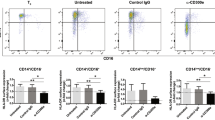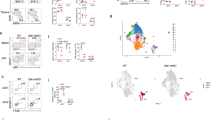Abstract
The molecular mechanisms that fine-tune Toll-like receptor (TLR)-triggered innate inflammatory responses remain to be fully elucidated. Major histocompatibility complex (MHC) molecules can mediate reverse signaling and have nonclassical functions. Here we found that constitutively expressed membrane MHC class I molecules attenuated TLR-triggered innate inflammatory responses via reverse signaling, which protected mice from sepsis. The intracellular domain of MHC class I molecules was phosphorylated by the kinase Src after TLR activation, then the tyrosine kinase Fps was recruited via its Src homology 2 domain to phosphorylated MHC class I molecules. This led to enhanced Fps activity and recruitment of the phosphatase SHP-2, which interfered with TLR signaling mediated by the signaling molecule TRAF6. Thus, constitutive MHC class I molecules engage in crosstalk with TLR signaling via the Fps–SHP-2 pathway and control TLR-triggered innate inflammatory responses.
This is a preview of subscription content, access via your institution
Access options
Subscribe to this journal
Receive 12 print issues and online access
$209.00 per year
only $17.42 per issue
Buy this article
- Purchase on Springer Link
- Instant access to full article PDF
Prices may be subject to local taxes which are calculated during checkout








Similar content being viewed by others
Change history
04 May 2012
In the version of this article initially published online, some labels in Figs. 3b and 7c were incorrect and the legend for Fig. 7c incorrectly identified the siRNA used. In Fig. 3b, the label 'siRNA:' (to identify the siRNA used) should be in the left margin adjacent to 'Ctrl'; the label 'MHCI' (to identify the protein detected) should be in the left margin below that. For Fig. 7c, the label above the right lane should read 'Fps'; its accompanying legend should end "...control or Fps-specific siRNA." The error has been corrected for the print, PDF and HTML versions of this article.
References
Kawai, T. & Akira, S. The role of pattern-recognition receptors in innate immunity: update on Toll-like receptors. Nat. Immunol. 11, 373–384 (2010).
Iwasaki, A. & Medzhitov, R. Regulation of adaptive immunity by the innate immune system. Science 327, 291–295 (2010).
O'Neill, L.A. & Bowie, A.G. The family of five: TIR-domain-containing adaptors in Toll-like receptor signalling. Nat. Rev. Immunol. 7, 353–364 (2007).
Liew, F.Y., Xu, D., Brint, E.K. & O'Neill, L.A. Negative regulation of toll-like receptor-mediated immune responses. Nat. Rev. Immunol. 5, 446–458 (2005).
Antoniou, A.N., Powis, S.J. & Elliott, T. Assembly and export of MHC class I peptide ligands. Curr. Opin. Immunol. 15, 75–81 (2003).
Raulet, D.H. MHC class I-deficient mice. Adv. Immunol. 55, 381–421 (1994).
Nitta, T. et al. Thymoproteasome shapes immunocompetent repertoire of CD8+ T cells. Immunity 32, 29–40 (2010).
Orr, M.T. & Lanier, L.L. Natural killer cell education and tolerance. Cell 142, 847–856 (2010).
Jonsson, A.H. & Yokoyama, W.M. Natural killer cell tolerance licensing and other mechanisms. Adv. Immunol. 101, 27–79 (2009).
Elliott, J.M., Wahle, J.A. & Yokoyama, W.M. MHC class I-deficient natural killer cells acquire a licensed phenotype after transfer into an MHC class I-sufficient environment. J. Exp. Med. 207, 2073–2079 (2010).
Tscherning, T. & Claesson, M.H. Signal transduction via MHC class-I molecules in T cells. Scand. J. Immunol. 39, 117–121 (1994).
Skov, S. lntracellular signal transduction mediated by ligation of MHC class I molecules. Tissue Antigens 51, 215–223 (1998).
Pedersen, A.E., Skov, S., Bregenholt, S., Ruhwald, M. & Claesson, M.H. Signal transduction by the major histocompatibility complex class I molecule. APMIS 107, 887–895 (1999).
Yang, J. et al. Targeting β2-microglobulin for induction of tumor apoptosis in human hematological malignancies. Cancer Cell 10, 295–307 (2006).
Zhang, X., Rozengurt, E. & Reed, E.F. HLA class I molecules partner with integrin β4 to stimulate endothelial cell proliferation and migration. Sci. Signal. 3, ra85 (2010).
Rubio, G. et al. Cross-linking of MHC class I molecules on human NK cells inhibits NK cell function, segregates MHC I from the NK cell synapse, and induces intracellular phosphotyrosines. J. Leukoc. Biol. 76, 116–124 (2004).
Skov, S., Odum, N. & Claesson, M.H. MHC class I signaling in T cells leads to tyrosine kinase activity and PLC-γ1 phosphorylation. J. Immunol. 154, 1167–1176 (1995).
Pedersen, A.E., Bregenholt, S., Skov, S., Vrang, M.L. & Claesson, M.H. Protein tyrosine kinases p53/56lyn and p72syk in MHC class I-mediated signal transduction in B lymphoma cells. Exp. Cell Res. 240, 144–150 (1998).
Liu, X. et al. Intracellular MHC class II molecules promote TLR-triggered innate immune responses by maintaining activation of the kinase Btk. Nat. Immunol. 12, 416–424 (2011).
Han, C. et al. Integrin CD11b negatively regulates TLR-triggered inflammatory responses by activating Syk and promoting degradation of MyD88 and TRIF via Cbl-b. Nat. Immunol. 11, 734–742 (2010).
Sun, J.C. & Lanier, L.L. Cutting edge: viral infection breaks NK cell tolerance to “missing self”. J. Immunol. 181, 7453–7457 (2008).
Perona-Wright, G. et al. Systemic but not local infections elicit immunosuppressive IL-10 production by natural killer cells. Cell Host Microbe 6, 503–512 (2009).
Zirngibl, R.A., Senis, Y. & Greer, P.A. Enhanced endotoxin sensitivity in fps/fes-null mice with minimal defects in hematopoietic homeostasis. Mol. Cell. Biol. 22, 2472–2486 (2002).
Santos, S.G., Powis, S.J. & Arosa, F.A. Misfolding of major histocompatibility complex class I molecules in activated T cells allows cis-interactions with receptors and signaling molecules and is associated with tyrosine phosphorylation. J. Biol. Chem. 279, 53062–53070 (2004).
Udell, C.M., Samayawardhena, L.A., Kawakami, Y., Kawakami, T. & Craig, A.W. Fer and Fps/Fes participate in a Lyn-dependent pathway from FcɛRI to platelet-endothelial cell adhesion molecule 1 to limit mast cell activation. J. Biol. Chem. 281, 20949–20957 (2006).
Rui, Y. et al. PECAM-1 ligation negatively regulates TLR4 signaling in macrophages. J. Immunol. 179, 7344–7351 (2007).
An, H. et al. SHP-2 phosphatase negatively regulates the TRIF adaptor protein-dependent type I interferon and proinflammatory cytokine production. Immunity 25, 919–928 (2006).
Sun, M. & Fink, P.J. A new class of reverse signaling costimulators belongs to the TNF family. J. Immunol. 179, 4307–4312 (2007).
Greenwald, R.J., Freeman, G.J. & Sharpe, A.H. The B7 family revisited. Annu. Rev. Immunol. 23, 515–548 (2005).
Chen, L. Co-inhibitory molecules of the B7–CD28 family in the control of T-cell immunity. Nat. Rev. Immunol. 4, 336–347 (2004).
Kim, K.D. et al. Adaptive immune cells temper initial innate responses. Nat. Med. 13, 1248–1252 (2007).
Zimmer, J. et al. Clinical and immunological aspects of HLA class I deficiency. QJM 98, 719–727 (2005).
Gadola, S.D., Moins-Teisserenc, H.T., Trowsdale, J., Gross, W.L. & Cerundolo, V. TAP deficiency syndrome. Clin. Exp. Immunol. 121, 173–178 (2000).
Colonna, M. et al. Human myelomonocytic cells express an inhibitory receptor for classical and nonclassical MHC class I molecules. J. Immunol. 160, 3096–3100 (1998).
Arosa, F.A., Santos, S.G. & Powis, S.J. Open conformers: the hidden face of MHC-I molecules. Trends Immunol. 28, 115–123 (2007).
Little, A.M., Nossner, E. & Parham, P. Dissociation of β2-microglobulin from HLA class I heavy chains correlates with acquisition of epitopes in the cytoplasmic tail. J. Immunol. 154, 5205–5215 (1995).
Izuhara, K., Feldman, R.A., Greer, P. & Harada, N. Interaction of the c-fes proto-oncogene product with the interleukin-4 receptor. J. Biol. Chem. 269, 18623–18629 (1994).
Matsuda, T. et al. Activation of Fes tyrosine kinase by gp130, an interleukin-6 family cytokine signal transducer, and their association. J. Biol. Chem. 270, 11037–11039 (1995).
Brizzi, M.F. et al. Granulocyte-macrophage colony-stimulating factor stimulates JAK2 signaling pathway and rapidly activates p93fes, STAT1 p91, and STAT3 p92 in polymorphonuclear leukocytes. J. Biol. Chem. 271, 3562–3567 (1996).
Filippakopoulos, P. et al. Structural coupling of SH2-kinase domains links Fes and Abl substrate recognition and kinase activation. Cell 134, 793–803 (2008).
Hellwig, S. & Smithgall, T.E. Structure and regulation of the c-Fes protein-tyrosine kinase. Front. Biosci. 17, 3146–3155 (2011).
Greer, P. Closing in on the biological functions of Fps/Fes and Fer. Nat. Rev. Mol. Cell Biol. 3, 278–289 (2002).
Lorenz, U. SHP-1 and SHP-2 in T cells: two phosphatases functioning at many levels. Immunol. Rev. 228, 342–359 (2009).
Parsons, S.A. & Greer, P.A. The Fps/Fes kinase regulates the inflammatory response to endotoxin through down-regulation of TLR4, NF-κB activation, and TNF-α secretion in macrophages. J. Leukoc. Biol. 80, 1522–1528 (2006).
Xu, S. et al. IL-17A-producing γδT cells promote CTL responses against Listeria monocytogenes infection by enhancing dendritic cell cross-presentation. J. Immunol. 185, 5879–5887 (2010).
Acknowledgements
We thank G. Feng (University of California, San Diego) for mice with loxP-flanked alleles encoding SHP-2; H. Shen (University of Pennsylvania School of Medicine) for L. monocytogenes; N. van Rooijen (Free University of Amsterdam) for liposomes; J. Long, X. Zuo and P. Ma for technical assistance; and T. Chen and Y. Han for discussions. Supported by the National Key Basic Research Program of China (2012CB910202 and 2010CB911903), the National 125 Key Project (2012ZX10002-014 and 2012AA020901), the National Natural Science Foundation of China (81123006) and the Shanghai Committee of Science and Technology (10DZ1910300).
Author information
Authors and Affiliations
Contributions
X.C. and S.X. designed the experiments; S.X., X.L., Y.B., C.H., X.Zhu, P.Z., W.L. and X.Zha. did the experiments; X.C., S.X. and X.L. analyzed data and wrote the paper; and X.C. was responsible for research supervision, coordination and strategy.
Corresponding author
Ethics declarations
Competing interests
The authors declare no competing financial interests.
Supplementary information
Supplementary Text and Figures
Supplementary Figures 1–8 (PDF 869 kb)
Rights and permissions
About this article
Cite this article
Xu, S., Liu, X., Bao, Y. et al. Constitutive MHC class I molecules negatively regulate TLR-triggered inflammatory responses via the Fps–SHP-2 pathway. Nat Immunol 13, 551–559 (2012). https://doi.org/10.1038/ni.2283
Received:
Accepted:
Published:
Issue Date:
DOI: https://doi.org/10.1038/ni.2283
This article is cited by
-
Soluble CD4 effectively prevents excessive TLR activation of resident macrophages in the onset of sepsis
Signal Transduction and Targeted Therapy (2023)
-
Outside-in signaling through the major histocompatibility complex class-I cytoplasmic tail modulates glutamate receptor expression in neurons
Scientific Reports (2023)
-
Immunogenicity of lipid nanoparticles and its impact on the efficacy of mRNA vaccines and therapeutics
Experimental & Molecular Medicine (2023)
-
Microglia and macrophage exhibit attenuated inflammatory response and ferroptosis resistance after RSL3 stimulation via increasing Nrf2 expression
Journal of Neuroinflammation (2021)
-
Phosphatases in toll-like receptors signaling: the unfairly-forgotten
Cell Communication and Signaling (2021)



